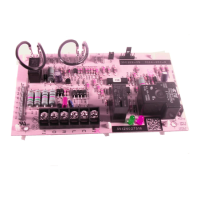Page 3
Test Mode Sequence
Using the defrost termination pin, short the TEST pins for
a period of two seconds:
Clear timed lockout / or pressure switch lockout
function.
Enter defrost mode
After entering forced defrost, if the jumper is removed
before 5 seconds has elapsed, the unit will remain in forced
defrost mode until defrost thermostat opens or terminated
on maximum defrost time (14 minutes). If the jumper is not
removed, once 5 seconds has elapsed (7 seconds total),
the unit will terminate defrost and return to heat mode. The
TEST mode will then be lockedout and no further TEST
mode operation will be executed until the jumper on the
TEST pins is removed and reapplied to the applicable
defrost termination pins.
IMPORTANT
NOTE - After testing has been completed, properly re
position test jumper across desired timing pins.
Compressor Delay (P5)
The 10026905 control, with the 30 second field
selectable delay, is active when the pins are jumpered.
This feature helps reduce occasional sounds that may
occur while the unit is cycling In and Out of the defrost
mode.
NOTE — The 30‐second compressor feature is ignored
when jumper is installed on TEST pins.
Compressor Anti-Short-Cycle Delay
The timed-off delay is five minutes long. The delay helps
protect the compressor from short-cycling in case the
power to the unit is interrupted or a pressure switch opens.
The delay is bypassed by placing the timer select jumper
across the TEST pins for 0.5 seconds.
NOTE - The defrost control must have a thermostat
demand for the bypass function to operate
Pressure Switch Circuits
The defrost control includes two pressure switch circuits.
The factory-installed high pressure switch (S4) wires are
connected to the defrost control's HI PS terminals (figure
1). The defrost control also includes LO PS terminals to
accommodate an optional field-provided low (or
loss‐of‐charge) pressure switch.
During a single thermostat cycle, the defrost control will
lock out the unit after the fifth time that the circuit is
interrupted by any pressure switch that is wired to the
defrost control. In addition, the diagnostic LEDs will
indicate a pressure switch lockout after the fifth occurrence
of an open pressure switch (see table 1). The unit will
remain locked out until 24V power from the indoor unit is
broken then remade to the control or until the jumper is
applied to the TEST pins for 0.5 seconds.
NOTE - The defrost control ignores input from the low
pressure switch terminals during the TEST mode, during
the defrost cycle, during the 90-second start-up period,
and for the first 90 seconds each time the reversing valve
switches heat/cool modes. If the TEST pins are
jumpered and the 5-minute delay is being bypassed,
the LO PS terminal signal is not ignored during the
90-second start-up period.
DIAGNOSTIC LEDS
The defrost control uses two LEDs for diagnostics. The
LEDs flash a specific sequence according to the diagnosis.
See table 1.
Table 1. Defrost Control Diagnostic LEDs
DS2 Green DS1 Red Condition
OFF OFF Power problem
Simultaneous Slow Flash Normal operation
Alternating Slow Flash 5-min. anti-short cycle delay
OFF Slow Flash Low Pressure Fault
OFF ON Low Pressure Lockout
Slow Flash OFF High Pressure Fault
ON OFF High Pressure Lockout
Service Light Connection
The switch is electrically connected to the service light in
the indoor 24 volt mercury style room thermostat. The
service light, when lit, indicates the compressor is not
running. The service light is powered from W1 terminal of
the indoor thermostat. The service light thermostat will
close and light when the discharge line falls below 110 +/-
5°F, indicating a problem in the system. The service light
thermostat opens and the service light goes off when the
discharge line temperature falls to 130 +/- 5°F indicating
the compressor is running. On late model units, the service
light connections are made on terminals on the defrost
control.
Ambient Compensating Thermistor
NOTE - The ambient compensator thermistor is not
required with 24 volt electronic thermostats.
Units built PRIOR to March 2002 have an ambient
compensating thermistor mounted on the outdoor fan
wiring harness. The thermistor is an NTC (negative
temperature coefficient – increase in temperature equals
decrease in resistance). The device is connected in series
with the heat anticipation resistor in the 24 volt mercury
style room thermostats. The thermistor varies the room
thermostat heat anticipator current according to outdoor
ambient temperature to prevent abnormal thermostat
droop. As outdoor temperature increases, the resistance
across the thermistor drops. As the resistance across the
thermistor drops, the current through the heat anticipator
resistor increases. Therefore, heat anticipation increases
as outdoor temperature decreases. (Resistance at 77ºF =
260 ohms +/- 5%; at 100ºF = 150 ohms; at 32ºF = 861
ohms). On late model units, the ambient thermistor
connections are made at terminals on the defrost control.

